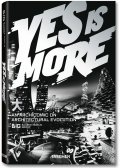BIG [Bjarke Ingels Group]
American release by Taschen Books
I am rarely willing to leaf through any modern monographs, most are photos or illustrations of projects lacking any sort of process or context, a form of self congratulatory masturbation. My stomach is much more willing to accept pseudo intellectual meanderings found in most modern criticism then vapid explanations of window location or careless asides towards materiality (wood is natural, so we used it!). Lately, my views have taken a more professorial role as I search for tomes that can be dissected and easily assimilated by the 2nd year architecture design studio I have taken to teaching lately. The fundamental class rests mostly on convincing the students that developing an organization and language for their design, based upon some sort of studied intent will allow them to explain their design in a logical and concise manner instead of relying on replicating historical styles or architectural moves. Sure we rely on a standard palette for solid and void, point/line/plane, etc. but we deviate from classical orders and proportions so that the students can practice space making on their own.
When was first handed a copy of Yes Is More by a GA two years ago I was immediately taken aback by the how the projects were very simple diagrammatic structures coupled with a healthy dose of post rationalization (the balcony view) and iteration, all topics that I find fundamental to good design creation (and explanation). Stumbling across the video for 8-House I was convinced, here was a source I could share with the students. There in lies the power of Yes Is More and BIG.
Based upon a showing of work at the Danish Architecture Center, the Yes Is More compendium is a supplement to an exhibit, edited to stand alone as a cartoon walkthrough of projects. Instead of merely showing finished projects, there is explanation of context, relationships and iterations which illustrate how important constant development and flexibility can be. The intent of the project is always evolving, consuming new information in a manner that allows the project response to be specific, not just to site but also to society in an easily digestible manner.
That is BIG's largest strength and most powerful tool in the propaganda box (don't get me wrong, this is propaganda at it's very base and very well executed). People, society loves to feel clever, we loathe things that make us feel weak and stupid. If an architect can explain their project (no matter the complexity) in a manner that allows the public to not only understand but possibly anticipate, the public feels as if they can understand this obtuse thing, architecture. This can be done without the dangerous democratization of design as BIG illustrates in the Yes Is More work. Simple diagramming, obvious slight of hand with imagery, brief synapses of explanation in lieu of drawn out treatises make the work not only accessible but quite easy to like. All this is accomplished without sacrificing the design intent, which makes it all the more impressive. While many of the projects are unbuilt quick renderings lacking structural significance, there is enough expressed to understand the creation of the spaces, which is what the architecture is really about anyway.
Yes Is More coupled with the BIG Vimeo channel is showing the marketing savvy of Ingels, making architecture (that pushes the boundaries to some extent) accessible to the general public which in turn is good for all of us struggling with how to explain what we want to do with our big words and oversized glossy images.


No comments:
Post a Comment